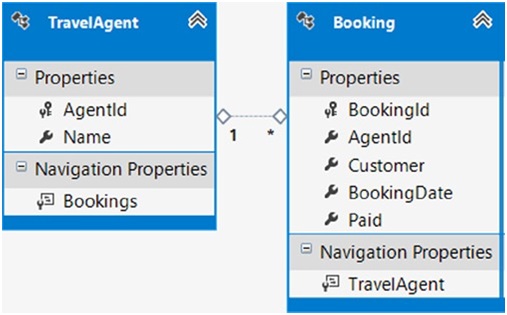9-3. 找出Web API中发生了什么变化
问题
想通过基于REST的Web API服务对数据库进行插入,删除和修改对象图,而不必为每个实体类编写单独的更新方法. 此外, 用EF6的Code Frist实现数据访问管理.
本例,我们模拟一个N层场景,用单独的客户端(控制台应用)来调用单独的基于REST服务的Web网站(WEB API应用)
. 注意:每层使用单独的Visual Studio 解决方案, 这样更方便配置、调试和模拟一个N层应用。
假设有一个如Figure 9-3所示的旅行社和预订的模型.

Figure 9-3. 一个旅行社和预订的模型
模型展示了旅行社和他们的预订之间的关系. 我们要把模型和数据库访问放到WEB API服务后面,这样任何客户端都可以通过HTTP来插入,更新和删除订单。
先建立服务,执行以下步骤:
1.创建一个新的 ASP.NET MVC 4 Web应用, 在向导中选择Web API模板. 把项目命名为:Recipe3.Service.
2.向项目添加一个Web API 控制器,命名为:TravelAgentController.
3. 接下来,添加如Listing 9-12的TravelAgent和Booking实体类.
Listing 9-12. Travel Agent and Booking Entity Classes
public class TravelAgent
{
public TravelAgent()
{
this.Bookings = new HashSet<Booking>();
}
public int AgentId { get; set; }
public string Name { get; set; }
public virtual ICollection<Booking> Bookings { get; set; }
}
public class Booking
{
public int BookingId { get; set; }
public int AgentId { get; set; }
public string Customer { get; set; }
public DateTime BookingDate { get; set; }
public bool Paid { get; set; }
public virtual TravelAgent TravelAgent { get; set; }
}
4. 在“Recipe1.Service ”项目中添加EF6的引用。最好是借助 NuGet 包管理器来添加。在”引用”上右击,选择”管理 NuGet 程序包.从“联机”标签页,定位并安装EF6包。这样将会下载,安装并配置好EF6库到你的项目中。.
5. 添加一个类,命名为:Recipe3Context, 添加如Listing 9-13的代码,
确保它继承DbContext类.
Listing 9-13. Context Class
public class Recipe3Context : DbContext
{
public Recipe3Context() : base("Recipe3ConnectionString") { }
public DbSet<TravelAgent> TravelAgents { get; set; }
public DbSet<Booking> Bookings { get; set; }
protected override void OnModelCreating(DbModelBuilder modelBuilder)
{
modelBuilder.Entity<TravelAgent>().HasKey(x => x.AgentId);
modelBuilder.Entity<TravelAgent>().ToTable("Chapter9.TravelAgent");
modelBuilder.Entity<Booking>().ToTable("Chapter9.Booking");
}
}
6. 接着, 把如Listing 9-14的Recipe3ConnectionString连接字符串添加到Web.Config文件里ConnectionStrings节里.
Listing 9-14. Web API 服务里的Recipe3Context的连接字符串
<connectionStrings>
<add name="Recipe3ConnectionString"
connectionString="Data Source=.;
Initial Catalog=EFRecipes;
Integrated Security=True;
MultipleActiveResultSets=True"
providerName="System.Data.SqlClient" />
</connectionStrings>
7. 把Listing 9-15里的代码插入到Global.asax的Application_Start 方法里. 这些代码禁止EF进行模型兼容性检查和指示JSON序列时忽略由TravelAgent 和Booking类之间导航属性的双向引用所引来的循环引用问题。Listing 9-15. Disable the Entity Framework Model Compatibility Check
protected void Application_Start()
{
//禁止EF进行模型兼容性检查
Database.SetInitializer<Recipe3Context>(null);
//实体之间导航属性如果循环引用会使web api在进行Json序列化一个对象时出错,这是Json.net在序列//时默认情况。为了解决这个问题,简单的配置JSON序列化器忽略循环引用。
GlobalConfiguration.Configuration.Formatters.JsonFormatter
.SerializerSettings.ReferenceLoopHandling =
Newtonsoft.Json.ReferenceLoopHandling.Ignore;
...
}
8. 依照Listing 9-16修改Web API的RouteConfig.cs文件的路由配置
Listing 9-16. Modifications to RouteConfig Class to Accommodate RPC-Style Routing
public static void Register(HttpConfiguration config)
{
config.Routes.MapHttpRoute(
name: "ActionMethodSave",
routeTemplate: "api/{controller}/{action}/{id}",
defaults: new { id = RouteParameter.Optional }
);
}
9. 最后, 用Listing 9-17里的代码替换TravelAgentController里的代码
Listing 9-17. Travel Agent Web API Controller
public class TravelAgentController : ApiController
{
// GET api/travelagent
[HttpGet]
public IEnumerable<TravelAgent> Retrieve()
{
using (var context = new Recipe3Context())
{
return context.TravelAgents.Include(x => x.Bookings).ToList();
}
}
/// <summary>
/// 通过Web API 的路由,执行该更新 TravelAgent的方法
/// </summary>
public HttpResponseMessage Update(TravelAgent travelAgent)
{
using (var context = new Recipe3Context())
{
var newParentEntity = true;
// 添加一个实体,并给它的对象图(包含父与子实体)设置一个State值,让context知道哪些实体需要更新
context.TravelAgents.Add(travelAgent);
if (travelAgent.AgentId > 0)
{
// ID值大于0,表示这是一个已经存在于数据库的时候,我们要把该实体的state设置为updated
context.Entry(travelAgent).State = EntityState.Modified;
newParentEntity = false;
}
//通过迭代子实体,并分配正确的state.
foreach (var booking in travelAgent.Bookings)
{
if (booking.BookingId > 0)
// ID值大于0,表示booking已经存在,并把该实体的State设置为Modified.
context.Entry(booking).State = EntityState.Modified;
}
context.SaveChanges();
HttpResponseMessage response;
//根据实体State设置Http状态码
response = Request.CreateResponse(newParentEntity
? HttpStatusCode.Created : HttpStatusCode.OK, travelAgent);
return response;
}
}
[HttpDelete]
public HttpResponseMessage Cleanup()
{
using (var context = new Recipe3Context())
{
context.Database.ExecuteSqlCommand("delete from chapter9.booking");
context.Database.ExecuteSqlCommand("delete from chapter9.travelagent");
}
return Request.CreateResponse(HttpStatusCode.OK);
}
}
接下来我们创建调用上述服务的客户端.
10. 创建一个解决方案,添加一个控制台应用程序,命名为: Recipe3.Client.
11.用Listing 9-18的代码program.cs里的代码
Listing 9-18. Our Windows Console Application That Serves as Our Test Client
internal class Program
{
private HttpClient _client;
private TravelAgent _agent1, _agent2;
private Booking _booking1, _booking2, _booking3;
private HttpResponseMessage _response;
private static void Main()
{
Task t = Run();
t.Wait();
Console.WriteLine(" Press <enter> to continue...");
Console.ReadLine();
}
private static async Task Run()
{
var program = new Program();
program.ServiceSetup();
//在清除之前数据以前,不往下执行
await program.CleanupAsync();
program.CreateFirstAgent();
//在创建agent前,不往下执行
await program.AddAgentAsync();
program.CreateSecondAgent();
//在创建agent前,不往下执行
await program.AddSecondAgentAsync();
program.ModifyAgent();
// 在更新agent前,不往下执行
await program.UpdateAgentAsync();
// do not proceed until agents are fetched
await program.FetchAgentsAsync();
}
private void ServiceSetup()
{
// 构造Web API的调用实例
_client = new HttpClient {BaseAddress = new Uri("http://localhost:6687/")};
// 添加接收头部媒体类型,使请求能接收由Web API返回的Json格式资源_client.DefaultRequestHeaders.Accept.Add(new MediaTypeWithQualityHeaderValue("application/json"));
}
private async Task CleanupAsync()
{
//调用服务端的cleanup方法
_response = await _client.DeleteAsync("api/travelagent/cleanup/");
}
private void CreateFirstAgent()
{
// 创建新的TravelAgent和booking对象
_agent1 = new TravelAgent {Name = "John Tate"};
_booking1 = new Booking
{
Customer = "Karen Stevens",
Paid = false,
BookingDate = DateTime.Parse("2/2/2010")
};
_booking2 = new Booking
{
Customer = "Dolly Parton",
Paid = true,
BookingDate = DateTime.Parse("3/10/2010")
};
_agent1.Bookings.Add(_booking1);
_agent1.Bookings.Add(_booking2);
}
private async Task AddAgentAsync()
{
//调用Web API服务中普通的update方法来添加agent和bookings
_response = await _client.PostAsync("api/travelagent/update/",
_agent1, new JsonMediaTypeFormatter());
if (_response.IsSuccessStatusCode)
{
//从服务端获取新创建的travel agent对象,它包含由数据库自增ID值
_agent1 = await _response.Content.ReadAsAsync<TravelAgent>();
_booking1 = _agent1.Bookings.FirstOrDefault(x => x.Customer == "Karen Stevens");
_booking2 = _agent1.Bookings.FirstOrDefault(x => x.Customer == "Dolly Parton");
Console.WriteLine("Successfully created Travel Agent {0} and {1} Booking(s)",
_agent1.Name, _agent1.Bookings.Count);
}
else
Console.WriteLine("{0} ({1})", (int) _response.StatusCode, _response.ReasonPhrase);
}
private void CreateSecondAgent()
{
// 创建新的agent和booking对象
_agent2 = new TravelAgent {Name = "Perry Como"};
_booking3 = new Booking
{
Customer = "Loretta Lynn",
Paid = true,
BookingDate = DateTime.Parse("3/15/2010")
};
_agent2.Bookings.Add(_booking3);
}
private async Task AddSecondAgentAsync()
{
// 调用Web API 服务中普通的update 方法,来添加 agent 和booking
_response = await _client.PostAsync("api/travelagent/update/",
_agent2, new JsonMediaTypeFormatter());
if (_response.IsSuccessStatusCode)
{
//从服务端获取新创建的travel agent对象,它包含由数据库自增ID值
_agent2 = await _response.Content.ReadAsAsync<TravelAgent>();
_booking3 = _agent2.Bookings.FirstOrDefault(x => x.Customer == "Loretta Lynn");
Console.WriteLine("Successfully created Travel Agent {0} and {1} Booking(s)",
_agent2.Name, _agent2.Bookings.Count);
}
else
Console.WriteLine("{0} ({1})", (int) _response.StatusCode, _response.ReasonPhrase);
}
private void ModifyAgent()
{
//修改agent 2的Name属性,并添加一个booking 1
_agent2.Name = "Perry Como, Jr.";
_agent2.Bookings.Add(_booking1);
}
private async Task UpdateAgentAsync()
{
// 调用Web API 服务中普通的update 方法,来更新 agent 2
_response = await _client.PostAsync("api/travelagent/update/",
_agent2, new JsonMediaTypeFormatter());
if (_response.IsSuccessStatusCode)
{
// 获取包含新ID值的从服务端返回的travel agent
_agent1 = _response.Content.ReadAsAsync<TravelAgent>().Result;
Console.WriteLine("Successfully updated Travel Agent {0} and {1} Booking(s)",
_agent1.Name, _agent1.Bookings.Count);
}
else
Console.WriteLine("{0} ({1})", (int) _response.StatusCode, _response.ReasonPhrase);
}
private async Task FetchAgentsAsync()
{
//调用服务端的Get方法,获取所有 Travel Agents 和 Bookings
_response = _client.GetAsync("api/travelagent/retrieve").Result;
if (_response.IsSuccessStatusCode)
{
//获取从服务端返回的包含ID值的新创建的 travel agent
var agents = await _response.Content.ReadAsAsync<IEnumerable<TravelAgent>>();
foreach (var agent in agents)
{
Console.WriteLine("Travel Agent {0} has {1} Booking(s)", agent.Name,
agent.Bookings.Count());
}
}
else
Console.WriteLine("{0} ({1})", (int) _response.StatusCode, _response.ReasonPhrase);
}
}
12. 最后,添加与服务端也就是Listing 9-12所列的相同的 TravelAgent 和Booking 类
以下Listing 9-18,是客户端输出结果:
============================================================================
Successfully created Travel Agent John Tate and 2 Booking(s)
Successfully created Travel Agent Perry Como and 1 Booking(s)
Successfully updated Travel Agent Perry Como, Jr. and 2 Booking(s)
Travel Agent John Tate has 1 Booking(s)
Travel Agent Perry Como, Jr. has 2 Booking(s)
=============================================================================
它是如何工作的
先运行Web API应用程序. 启动后会打开首页.至此, 网站已经在运行,并且服务已经可以使用.接着打开控制台项目, 在program.cs 首页设置断点, 运行控制台应用程序. 首先建立与服务端的管道连接,并配置请求头部媒体类型,使它能接收JSON格式,接着客户端执行DeleteAsync方法,它会调用Web API 中TravelAgent 控制器里的Cleanup方法,该方法会删除数据库表中的所有之前的数据。接着我们在客户端新建一个travel agent和两个booking对象,HttpClient对象调用PostAsync方法,向服务端传递这三个新建的对象,如果你在Web API的TravelAgent控制Update方法前加断点,你将会看到它的参数接收到TravelAgent以及它所包含的booking对象。Update方法会给TravelAgent做上Added或Modified的标志,而Context就会跟踪这些对象。
■■注意:你可能会用Add或Attach一组新的实体对象(例如:多个Booking的Id都为0)
.如果用Attach,EF会因为主键冲突抛出一个异常。
我们判断ID值为0,表示实体State是Added的,否则为Modified,我们又额外的利用newParentEntity变量作为是否为新实体的标志,以便正确返回Http状态码。
接着迭代TravelAgent所包含的booking实体,并给它们也做上Added或Modified的标志,
接着调用 SaveChanges 方法, 它会为Added状态实体生成插入语句,为Modified状态实体生成更新语句,然后,如果TravelAgent为Added返回http状态码201,如果为Modified返回200。状态码告知它的调用者操作已经成功完成
. 当分布基于REST服务时,最好是通过Http状态码来告知它的调用者操作的执行情况.
随后我们在客户端添加另一个新的travel agent和booking,利用PostAsync方法调用服务端的Update方法。
接着, 我们修改第二个Travel agent 实体的Name属性,并从第一个Travel agent 实体中移一个booking实体过来,此次我们调用 Update 方法时, 每个实体Id都有大于0的值, 所以会把这些实体的state设置为modified,所以保存时EF会成成Update的sql语句
最后,客户端通过httpclient的GetAsync方法调用服务端的 Retrieve 方法.该方法返回所有的travel agent 和booking 实体,此处我们简单的用Include()方法预先加载booking实体。
需要知道的是: JSON序列化器将会序列化实体的所有Public属性,即使你只投射(例如Select几个字段)几个属性。
本节, 我们封装EF的操作到一个Web API服务里.而客户端可以用HttpClient对象调用这些服务。这个例子里, 我们没有优先采用 Web API的 HTTP基于动作的分布方式,而是更多地采用基于RPC的路由方式
. 在实际项目中,你可能更喜欢利用HTTP的基于动作的方式, 因为它更符合 ASP.NET Web API的基于REST服务的意图。
在实际项目中,我们可能更乐意为EF数据访问单独创建一个层(Visual Studio类库),从而使它从Web API服务中剥离出来。